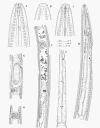The type species of the genus.
- Large nematodes 2.7 to 3.3 mm long
- Cuticle thick and smooth
- Lip region continuous with body contour; lips fused
- Amphids funnel-shaped
- Odontostyle short and thin; hook-like processes at base of
odontostyle
- Guiding ring double.
- Basal expansion about 60% of esophagus length
|
|
Female:
- Genital system amphidelphic.
- Vulva longitudinal, not sclerotized, sunk below body contour
- Tail short, rounded with a dorsall-curved finngerlike
projection.
|
 |
|
|
Namaquanema hanki: A,B,C head end; D
anterior body; E: esophageal expansion; F,G,H: reproductive system and
vulva region (from Heyns and Swart, 1993) |
|
Male:
- Prerectum starting anterior to supplements
- Supplements 13 to 15, contiguous
- Tail short, rounded, without projection
Ref: Andressy, 2009; Heyns and Swart, 1993
|
 |
| |
Namaquanema hanki: A,B,C female tail; D
male tail E spicule guiding piece; F: spicule (from Heyns and Swart,
1993) |
Reported median body size for this species (Length mm; width micrometers; weight micrograms) - Click:
The type species of the genus, reported and described from soil on the bank
of a small stream in north-western South Africa.
Probably and omnivore.
Predatory regulation of opportunistic species.
Andrassy, I. 2009. Free-living Nematodes of Hungary III. Hungarian
Natural History Museum, Budapest. 608p.
Heyns, J., Swart, A. 1993. Namaquanema hanki n. gen., n. sp. from South
Africa (Nematoda : Dorylaimoidea). Fundamental and Applied Nematology
16:171-175.
Yeates, G.W., T. Bongers, R. G. M. De Goede, D. W. Freckman, and S. S.
Georgieva. 1993. Feeding habits in soil nematode families and genera—An outline
for soil ecologists. Journal of Nematology 25:315-331.